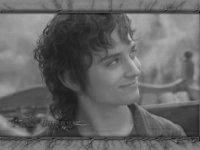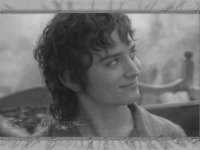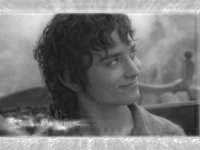August 16th, 2008 at 12:24 pm (Knitting, Music, Technology)
I got a 2 GB iPod Shuffle for my birthday (thanks, Mom!) — an entirely unanticipated gift. I’d never owned an MP3 player and, when I’d seen the Shuffle in stores, figured it wouldn’t really be all that useful — no display, you know? But then I got one of my own, and my world changed.
My favorite music is with me everywhere I go! This has literally transformed my commute (via tape adapter), my walks, and even washing the dishes (while I can play the same music through my laptop’s speakers, it sounds so much better through headphones). For walks, it’s almost as good as ThinkGeek’s personal soundtrack t-shirt, except that it doesn’t annoy others around me. (I do have to check my impulse to sing along, though!)
I thought the lack of a display would bug me. But it turns out that it supports the main ways I listen to music anyway — sequential, or random. If I don’t like the current song, I can just skip to the next one. What a beautiful little device!
Even better: I’ve discovered an actual use for podcasts! I’d experimented with a couple in the past, but whenever I’m actually using my computer, I’m almost always processing information (writing code, reading papers, work stuff) in a way that doesn’t permit me to pay attention to talk. But now… I can listen to podcasts in all of those same places (car, walks, dishes)! My favorites so far are:
- The Loh Life, by Sandra Tsing-Loh: I love her articles in the Atlantic Monthly and, the few times I’ve caught her in the mornings on KPCC, I’ve loved her short (~3-minute) monologues. But it never seems to sync up with my commute these days. No more! Now I have Sandra with me anytime I want! Edit: Sandra also has a daily 1-minute show called The Loh Down on Science!
- Cast On, by Brenda Dayne: I experimented with a few knitting podcats, but this is the only one that really stuck. I think I’d listen to “Cast On” even if I weren’t a knitter, just for the fabulous music she plays throughout the show. I haven’t recognized a single song, yet I’ve liked every one of them! The knitting-related material is great, too, from her “sweater of the day” stories to the thought-inspiring Essay.
Podcasts, like audio books, are definitely great for knitting accompaniment. Now my Shuffle makes it easy and portable. Can Apple ever go wrong?
3 Comments
August 15th, 2008 at 4:02 pm (Astronomy)
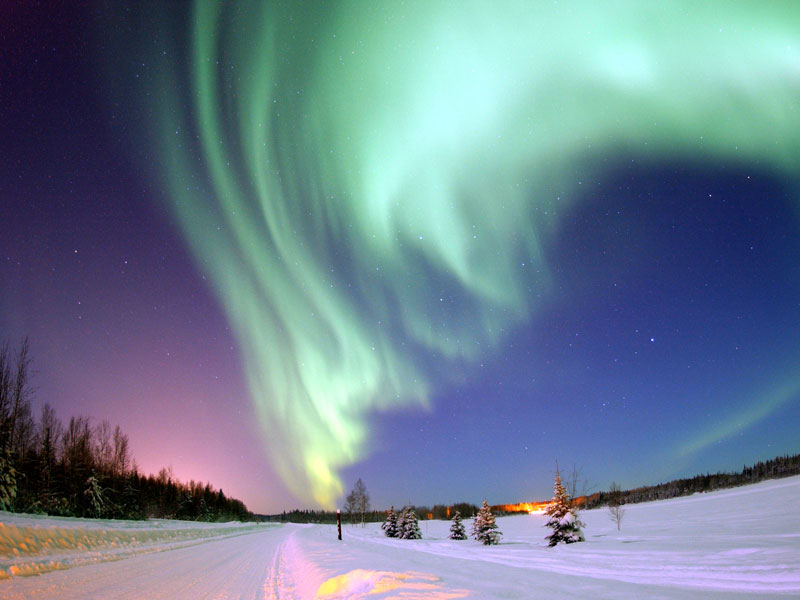 Unlike the International Space Station, the aurora remains a sky phenomenon that I have yet to witness with my own eyes. Yet I have read about and seen glorious images of the colored curtains of light, shifting suspended over arctic landscapes. While often yellow or green, some auroras are red or even purple (and some occur in the UV, not a “color” we perceive visually).
Unlike the International Space Station, the aurora remains a sky phenomenon that I have yet to witness with my own eyes. Yet I have read about and seen glorious images of the colored curtains of light, shifting suspended over arctic landscapes. While often yellow or green, some auroras are red or even purple (and some occur in the UV, not a “color” we perceive visually).
What causes the glorious color? What you’re seeing in the aurora is the result of a collision between charged particles streaming out from the sun and bits of the Earth’s upper atmosphere, where the energy resulting from that collision is given off as light. According to a recent Physics Today article titled “How do auroras form?” (by Robert J. Strangeway), the colors indicate the energy of the solar particles prior to collision:
For energies of a few electron volts or so, the aurora is red and emitted at altitudes above 200 km. Particles with energies of about 1 keV penetrate to lower altitudes and are responsible for the dominant yellow-green color of auroras. Even more energetic particles with energies above 10 keV can get to altitudes below 100 km; at such locations auroras are a deep red or purple color.
It makes sense to me that particle energy would correlate with penetration depth, and even with the energy (frequency) of the collision’s resulting radiation, which would dictate the color — although it seems a bit odd that this would not be monotonic (why would both low- and high-energy particles result in low-frequency colors (reds)?). However, wikipedia’s entry on auroras claims instead that the colors indicate what sort of atom or molecule in the atmosphere was on the unlucky receiving end of the collision:
Most aurorae are green and red emission from atomic oxygen. Molecular nitrogen and nitrogen ions produce some low level red and very high blue/violet aurorae. The light blue colors are produced by ionic nitrogen and the neutral nitrogen gives off the red and purple color with the rippled edges. Different gases interacting with the upper atmosphere will produce different colors, caused by the different compounds of oxygen and nitrogen.
So, is it the altitude (dictated by particle energy) or the composition? Probably both! Wikipedia continues:
Auroral electrons created by large geomagnetic storms often seem to have energies below 1 keV, and are stopped higher up, near 200 km. Such low energies excite mainly the red line of oxygen, so that often such auroras are red.
The energy dictates both altitude and which compositional responses you get.
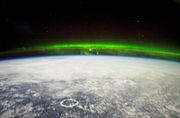 The aurora has been captured from above (onboard the ISS), too (see left).
The aurora has been captured from above (onboard the ISS), too (see left).
1 Comments
1 of 1 people learned something from this entry.
August 7th, 2008 at 9:14 pm (Spacecraft)
I saw the International Space Station with my own eyes for the first time today. It crossed over Los Angeles from about 8:52 p.m. to 8:57 p.m. (You can get a list of upcoming local flybys based on your zip code.) It was bright: magnitude -3.0, according to that website (“magnitude” of sky objects is inversely proportional to brightness). I watched it sail overhead, from the northwest towards the southeast. It was a solid light, moving so quickly that you might mistake it for an airplane, but then it became obvious that this was no low-altitude craft.
It was nearing Jupiter (within about 8 degrees by my estimate) and I was comparing their brightness. At first, I was sure it was brighter than Jupiter (which, my StarPilot software claims, is -2.6 magnitude, so that checks out). But then it started to get dimmer. I blinked, but I wasn’t imagining it. It got dimmer and then began to turn red, and as I watched, it entirely vanished!
Some quick geometric reasoning suggested that I did not just witness the fiery demise of the ISS. Instead, it must have crossed into the Earth’s shadow while I was watching. Given the time of day and the relative position of Sun, Earth, and ISS, that makes sense. The red color I would not have known whether to expect to see visually, but presumably it’s the same effect we see at sunsets: low-angle sunlight must cross through more atmosphere, absorbing more of the shorter-wavelength colors, and at the limit, red will preferentially shine through due to refraction even as the Sun is partly occluded. So the light I was seeing definitely wasn’t coming from some airplane’s headlight; it was reflected sunshine!
And not only did I see the ISS, but I witnessed an ISS eclipse.
2 Comments
1 of 1 people learned something from this entry.
August 4th, 2008 at 8:09 pm (Computers)
ImageMagick’s convert utility is the Swiss-Army knife of command-line image editing. I won’t get into all of the amazing tricks it can accomplish (you can even make animations and anaglyphs), but instead share a cool new thing I learned to do with it today. This command will generate a grayscale image that contains only the values from the “channel” you specify (R, G, B):
convert colorimage.jpg -channel R -separate grayimage-red.jpg
convert colorimage.jpg -channel G -separate grayimage-green.jpg
convert colorimage.jpg -channel B -separate grayimage-blue.jpg
So for example, you can take this good-looking guy:
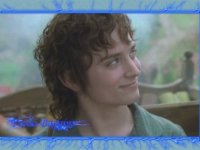
and split him into
You may be surprised to learn that this has direct bearing on my Geology Master’s thesis. I’m analyzing grayscale images of layered rocks to determine if they contain evidence of past life—and the way you convert from color to grayscale may matter (we’re going to test this).
Comments
August 1st, 2008 at 11:13 pm (Exercise, Nature)
I recently described a Difficulty 4+ hike with the Sierra Club, which was a bit more than I bargained for. This week, I went back and tackled a 3+ instead. The difference was like night and day! We hiked some of the same trail sections, but there were frequent stops that provided ample time to survey the darkening valleys, the rosy sunset, and the haze and fog flowing in. We weren’t constantly out of breath, so I actually got to catch up with my friends chatting. We did end up hiking the end part in deep dusk, but I’d brought a small LED light, and the leader actually switched on his headlamp to help guide the hikers past tricky bits.
In fact, the leaders (there were two) provided the biggest contrast from the leaders of the 4+ hike. They carefully checked at each stop that everyone had straggled up to maintain the group, they provided bits of trivia, and when one family needed to “check out” (head back to the parking lot) due to some health issues, one of the leaders split off to guide them back down personally. I really got the sense that the leaders were alert and took their responsibility very seriously; they were there to help everyone have a good time. The leaders of the 4+ hike seemed more intent on gamboling over the mountain for fun, paying only lip service to the concept of a “sweep” who follows along behind the slowest hiker to ensure that no one gets lost. On this 3+ hike, the leader checked frequently with the sweep (almost so often that it got annoying, but I’d rather have it that way).
This hike was definitely less physically demanding. I think I probably would most enjoy something between 3+ and 4+. Next time I’ll have to try a 4.
On the way out, around 9:30 p.m., I saw a coyote trot across the road near the parking lot, and we heard them yipping in the distance during the hike.
Comments



